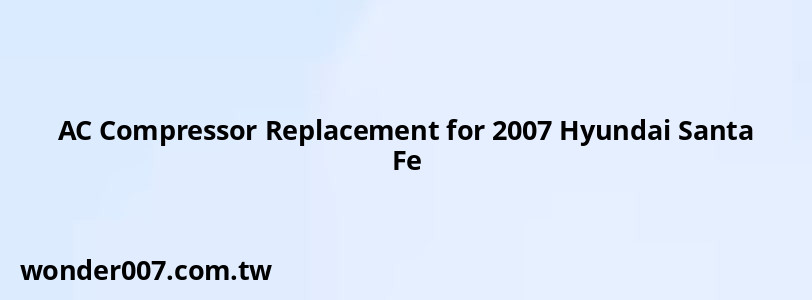AC Compressor Replacement for 2007 Hyundai Santa Fe

Replacing the AC compressor in a 2007 Hyundai Santa Fe can be a straightforward process, but it requires some mechanical knowledge and the right tools. This guide will provide step-by-step instructions, important tips, and cost considerations for those looking to tackle this repair themselves or understand what to expect if they take their vehicle to a professional.
Overview of AC Compressor Replacement
The AC compressor is a critical component of the vehicle's air conditioning system. It compresses refrigerant and circulates it through the system, enabling the AC to cool the cabin air. If your Santa Fe's AC is not functioning properly, a faulty compressor may be the culprit.
Tools and Parts Needed
Before starting the replacement, gather the following tools and parts:
- Tools:
- Ratchet and extensions
- Torque wrench
- Screwdrivers
- Dremel tool (if needed for stripped bolts)
- Pliers
- AC manifold gauge set (for refrigerant handling)
- Parts:
- Receiver drier or accumulator
- PAG oil (check specifications)
- O-rings or seals (often included with new compressor)
Step-by-Step Replacement Process
1. Preparation:
- Disconnect the negative battery terminal to ensure safety.
- Remove any engine covers or shields obstructing access to the compressor.
2. Remove the Serpentine Belt:
- Locate the tensioner pulley and use a ratchet to relieve tension on the belt. Slide the belt off the AC compressor pulley.
3. Disconnect Electrical Connections:
- Disconnect the electrical connector from the AC compressor by pressing down on the tab and pulling it out.
4. Disconnect Refrigerant Lines:
- Use a wrench to loosen and disconnect both high-pressure and low-pressure refrigerant lines from the compressor. Be cautious as refrigerant may escape.
5. Remove Mounting Bolts:
- Remove the bolts securing the compressor to its mounting bracket. There are typically four bolts; ensure they are kept in a safe place for reinstallation.
6. Remove Old Compressor:
- Carefully maneuver the old compressor out of its position. If space is tight, you may need to rotate or tilt it slightly.
7. Install New Compressor:
- Position the new compressor in place and secure it with mounting bolts. Tighten them to manufacturer specifications using a torque wrench.
8. Reconnect Refrigerant Lines:
- Attach both refrigerant lines to the new compressor, ensuring that O-rings are lubricated with PAG oil before installation to prevent leaks.
9. Reconnect Electrical Connector:
- Plug in the electrical connector back into the new compressor.
10. Reinstall Serpentine Belt:
- Place the serpentine belt back onto the pulleys, ensuring it is routed correctly according to your vehicle’s belt routing diagram.
11. Refill Refrigerant:
- Using an AC manifold gauge set, evacuate any remaining air from the system and refill it with refrigerant according to specifications.
12. Test System:
- Reconnect the battery terminal and start your vehicle. Turn on the AC system and check for proper operation and any unusual noises.
Cost Considerations
The average cost for replacing an AC compressor in a 2007 Hyundai Santa Fe ranges from approximately $1,222 to $1,484, including parts and labor if done by a professional mechanic. If you choose to do it yourself, you can save on labor costs but should still budget for parts which can range around $600-$800 depending on where you source them.
FAQs About AC Compressor Replacement
- How long does it take to replace an AC compressor?
Typically, it takes about 3-5 hours if you're experienced; however, first-time DIYers may take longer. - Can I drive my car without an AC compressor?
Yes, but you will lose air conditioning functionality, which may be uncomfortable in hot weather. - What should I do if my new compressor fails?
If your new compressor fails shortly after installation, check for proper installation and ensure no leaks are present.
Related Posts
-
Hyundai Santa Fe 2019 Wiper Blade Sizes Guide
28-01-2025 • 124 views -
Hyundai Elantra 2018: Headlight Bulb Size Guide
29-01-2025 • 199 views -
2012 Hyundai Tucson Serpentine Belt Diagram
31-01-2025 • 160 views -
Hyundai Outside Temperature Display: Troubleshooting Guide
27-01-2025 • 178 views -
2015 Hyundai Sonata Intake Camshaft Position Actuator
29-01-2025 • 90 views
Latest Posts
-
Power Steering Fluid Leak On Passenger Side
01-02-2025 • 392 views -
Rear Brake Caliper Piston Won't Compress
01-02-2025 • 287 views -
Are O2 Sensors Covered Under Warranty
01-02-2025 • 313 views -
2015 Chevy Traverse AC Recharge Port Location
01-02-2025 • 339 views -
How To Turn Off Paddle Shifters Mercedes
01-02-2025 • 306 views
Popular Posts
-
Power Steering and ABS Light On: Causes and Solutions
27-01-2025 • 582 views -
V12 Engine Costs: What You Need to Know
26-01-2025 • 584 views -
EPC Warning Light: What It Means for Your Vehicle
27-01-2025 • 559 views -
2015 VW Passat Oil Consumption Issues Explained
26-01-2025 • 544 views -
EPC Light: Understanding Causes and Solutions
26-01-2025 • 990 views
